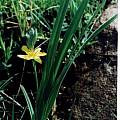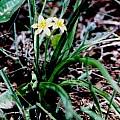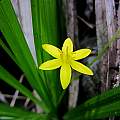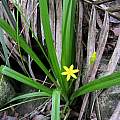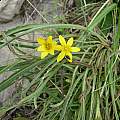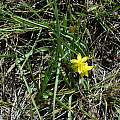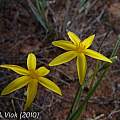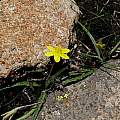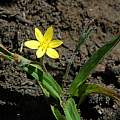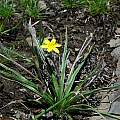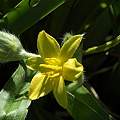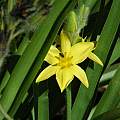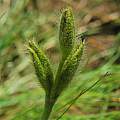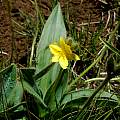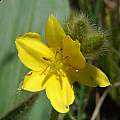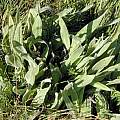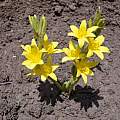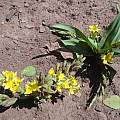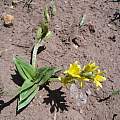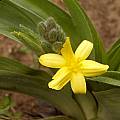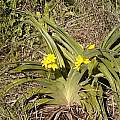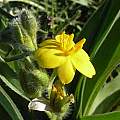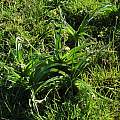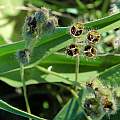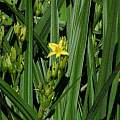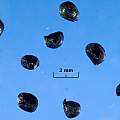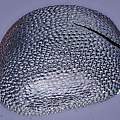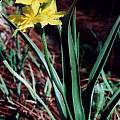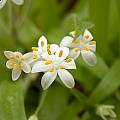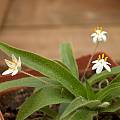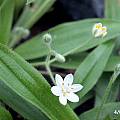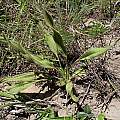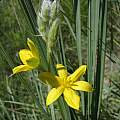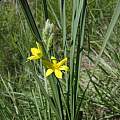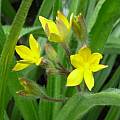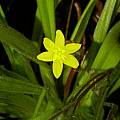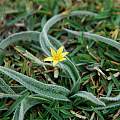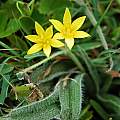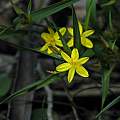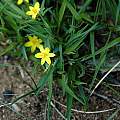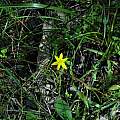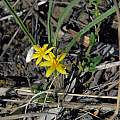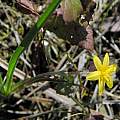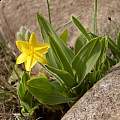Hypoxis is a large genus in the Hypoxidaceae family found in tropical and southern Africa, the Americas, Southeast Asia and Australia. The rootstock is a vertical rhizome. Leaves are often hairy and flowers star-shaped, usually yellow, but sometimes white. In 2013 in an article entitled The genus Pauridia (Hypoxidaceae) amplified to include Hypoxis sect. Ianthe, Saniella and Spiloxene, with revised nomenclature and typification written by Deirdre A. Snijman and Alexander Kocyan Hypoxis section Ianthe from Australia and New Zealand was included in Pauridia along with Saniella and Spiloxene. According to this article Hypoxis sect. Ianthe species are remarkably like the southern African Spiloxene species. "All are cormous, characteristically glabrous herbs, apart from a few, short teeth on the leaf margins in some species. The star-shaped flowers have six, rarely four, exposed stamens, a three-lobed stigma, and tepals which are mostly free from each other and inserted directly above the ovary." South African species are described as having vertical rhizomes, often large, subglobose to elongated.
Hypoxis acuminata Baker is found in damp grassland in the Eastern Cape. It has hairy leaves in a spiral tuft and yellow flowers in spring. Height: about 30 cm. Photo by Cameron McMaster was taken in the Amatola Mountains of the Eastern Cape, South Africa.
Hypoxis angustifolia Lam. has a carrot-like tuber, linear to lanceolate soft hairy leaves and 2 to 3 yellow flowers. It grows in grassland or rock crevices from Mossel Bay, South Africa to tropical Africa, Mauritius, and Madagascar. Height: 30 cm. Photo #1 by Cameron McMaster was taken in the Amatola Mountains of the Eastern Cape, South Africa. Photos #2-3 from Cameron McMaster were taken at the Kei River mouth in the Eastern Cape. The next two photos were taken near Balloch in the Eastern Cape by Bob Rutemoeller and Mary Sue Ittner, January 2010. The last photo from the book Plants of the Klein Karoo is courtesy of Jan and Anne Lise Schutte-Vlok.
Hypoxis argentea Harv. ex Baker grows in grassland, on rocky outcrops in the Eastern Cape, South Africa. It has narrow ribbed leaves with silky yellowish hairs and small yellow flowers. Height: 30 cm. Photos below were taken January 2010 by Cameron McMaster and Mary Sue Ittner on Gaika's Kop.
Hypoxis colchicifolia Baker grows on sandy or poor soils in grassland from the Eastern Cape to KwaZulu-Natal. It has erect firm, ribbed leaves and flowers from August to February. It is used medicinally to treat impotence, barrenness and as a love charm. Height range: 25-60 cm. Photos were taken by Mary Sue Ittner at Kirstenbosch National Botanical Garden January 2009.
Hypoxis costata Baker is a summer rainfall species southern Africa species found on stony, grassy slopes from 2050 to 2400 meters. It has broad rigid, sickle-shaped, ribbed leaves produced with flowers that are densely hairy or hairless. Flowering stems are as long as the leaves and the yellow flowers are large. Height: 25 cm. Photos 1-3 were taken January 2010 at Maclear by Mary Sue Ittner. Photos 4-5 were taken January 2010 by Bob Rutemoeller in the Eastern Cape.
Hypoxis goetzei Harms is distributed from southwest Kenya to southern tropical Africa. Height: about 30 cm. Photos by Nicholas Wightman were taken near Lilayi, Zambia.
Hypoxis hemerocallidea Fisch., C.A.Mey. & Avé-Lall. syn. Hypoxis rooperi T.Moore is found in marshy forest margins and grassland from the southern Cape to the Northern province, South Africa. Cameron McMaster wrote about it in an article for Farmer's Weekly in 2007. It has sickle-shaped keeled hairy leaves. The yellow flowers on branched stems are green and hairy on the reverse of the outer tepals and open mornings. In recent times it has been called the 'African potato' (in fact it grows from a corm) and there has been speculation about its pharmacological properties. It has been used in traditional medicine for a long time for a variety of ailments including HIV and AIDS, urinary cancer, and as a laxative and vermifuge. The seeds are stimulated to germinate by building a small fire on top of the flat to simulate a fire in their native grasslands. Height range: 30-60 cm. The first five photos by Cameron McMaster, Bob Rutemoeller and Mary Sue Ittner were taken in the Eastern Cape. The last photo from Mary Sue Ittner was taken in Kirstenbosch National Botanical Garden January 2009.
Seed photos by David Pilling. In the high magnification view it can be seen the seed is composed of hexagons and pentagons; in each of these there is a perfect reflection of the black lens aperture and surrounding diffuser.
Hypoxis longifolia Baker grows from a rhizome that has a neck densely surrounded by fibrous bristles. It grows on seasonal damp grassy flats and slopes in the southeast Cape. Leaves are strongly veined and reach above the flowers. Flowers are yellow. Height: about 20 cm. Photo were taken by Cameron McMaster in the Amatola Mountains of the Eastern Cape.
Hypoxis membranacea Baker is a species common in swampy areas, grassland, and mistbelt forest from the coast to the mountains, Eastern Cape to Lesotho. This species has leaves with scattered white hairs and small white flowers. Height: about 10 cm. Photos by Cameron McMaster including a close-up of the flowers, the whole plant illustrating hairy leaves and flowers, and finally a photo of a form with larger leaves that also shows the hairy flower buds.
Hypoxis multiceps Buchinger ex Baker is found in grassland up to 2000 m in the Eastern Cape. It has arching flat hairy rough leaves appearing after the flowers and 1-4 flowers opening in more or less opposite pairs. Height: about 30 cm. Photo by Cameron McMaster of the leaves was taken in the Eastern Cape.
Hypoxis occidentalis see Pauridia occidentalis (Benth.) Snijman & Kocyan
Hypoxis rigidula Baker is wide spread in South Africa, growing on grassy slopes up to 2300 m. It has flat, erect strongly ribbed hairy leaves and large yellow flowers. Height: to about 1 m. Photos by Cameron McMaster taken at Maclear.
Hypoxis sp. #3 Argentina was obtained from Yucca Do Nursery. Photos taken July & August 2003 by Lee Poulsen.
Hypoxis sp. was taken near Morgan Bay in the Eastern Cape by Mary Sue Ittner.
Hypoxis spp. seen, but not identified in Australia. These species could now be considered Pauridia species. Photos were taken by Mary Sue Ittner and Bob Rutemoeller. Photos 1-2 were taken at Porongurup National Park in Western Australia. The last photo was taken in the Grampians.
Hypoxis villosa L.f. is found on stony grassland and heath from Swellendam to KwaZulu-Natal. Growing from 15-25 cm, it has yellow flowers and spreading lanceolate hairy leaves. It usually flowers June to November. Photographs from Mary Sue Ittner of a plant identified by Dee Snijman that was flowering January 2010 on a cutting above a road near Cradock in the Eastern Cape.
Hypoxis zeyheri Baker shown in habitat on Mt. Kubusie in the Amatola Mountains of the Eastern Cape. Height: to about 60 cm. Photo taken by Cameron McMaster
